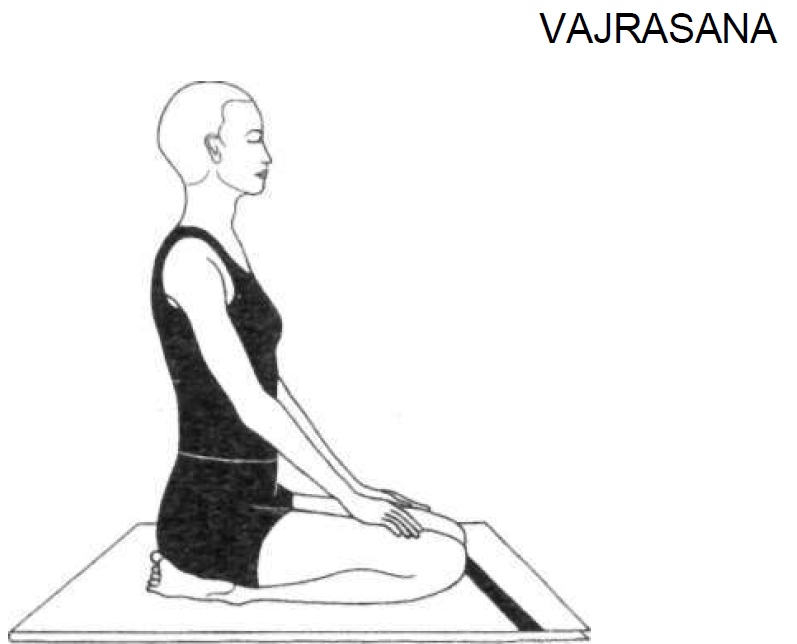Yoga Exercises for the Eyes

Yoga Starter 3
June 9, 2016
Healing Hand for Self Massage
June 9, 2016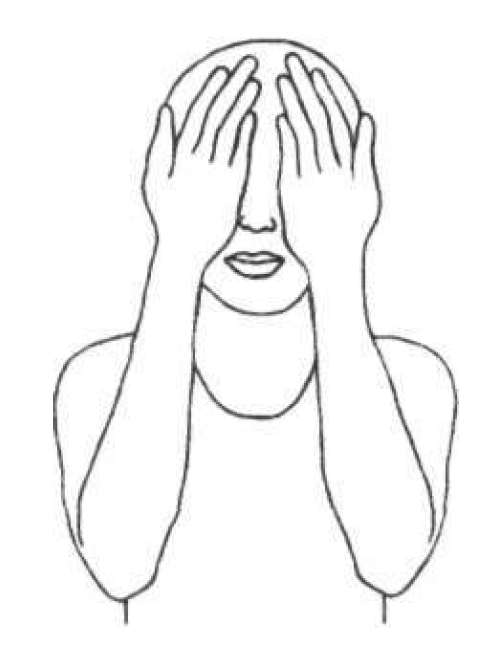
Palming 1
Exercise I: Palming
Sit quietly and close the eyes.
Rub the palms of the hands together vigorously until they become hot. Place the palms gently over the eyelids, without any undue pressure.
Feel the warmth and energy being transmitted from the hands into the eyes and the eye muscles relaxing.
The eyes are being bathed in a soothing darkness.
Remain in this position until the heat from the hands has been absorbed by the eyes.
Then lower the hands, keeping the eyes closed.
Again rub the palms together until they become hot and place them over the closed eyes. (Make sure the palms and not the fingers cover the eyes).
Repeat this procedure at least 3 times.
Benefits:
Palming relaxes and revitalises the eye muscles, and stimulates the circulation of the aqueous humour, the liquid that runs between the cornea and the lens of the eye, aiding the correction of defective vision.
Practice note:
The benefits are enhanced if the exercise is practised in front of the rising or setting sun. Be aware of
the warmth and light on the closed lids. Never look directly at the sun except for a few initial moments when it is just rising or when it is about to set.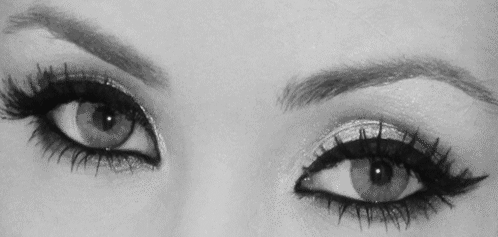
Blinking 2
Exercise 2: Blinking
Sit with the eyes open.
Blink the eyes 10 times quickly.
Close the eyes and relax for 20 seconds.
Repeat the blinking 10 times quickly and then again close the eyes and relax.
Repeat 5 times.
Benefits:
Many people with defective eyesight blink irregularly and unnaturally. This is related to the state of habitual tension in the eyes. This exercise encourages the blinking reflex to become spontaneous, inducing relaxation of the eye muscles.
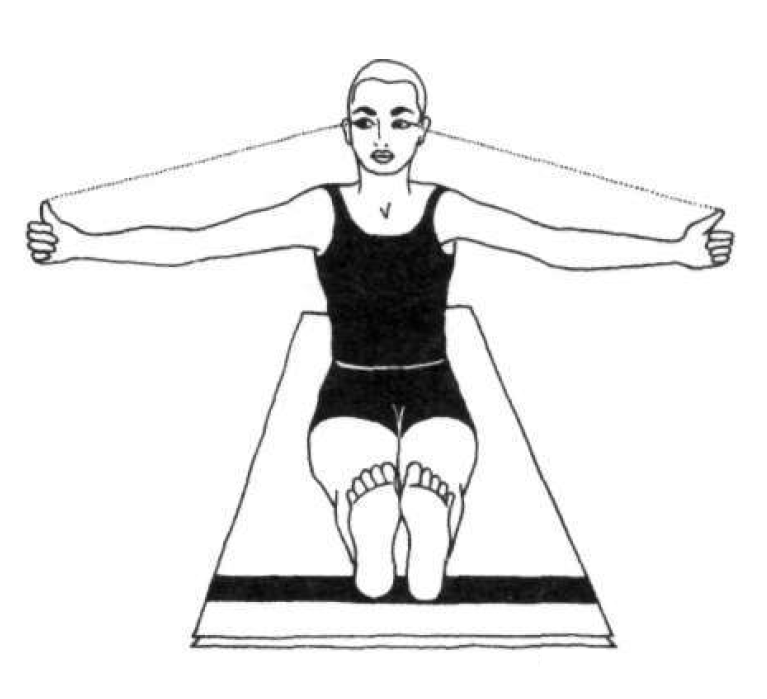
Sideways Viewing 3
Exercise 3: Sideways viewing
Assume a sitting position with the legs straight in front of the body.
Raise the arms to the sides at shoulder level, keeping them straight, and point the thumbs upwards.
The thumbs should be just in the peripheral vision when the head is facing forward. If they are not clearly visible, bring them slightly forward until they come into view. The head should not move. Look at a fixed point directly in front and on a level with the eyes. Fix the position of the head in this neutral position.
Then, without moving the head sideways, focus the eyes on the following, one after the other:
a) left thumb
b) space between the eyebrows, bhrumadhya
c) right thumb
d) space between the eyebrows
e) left thumb.Repeat this cycle 10 to 20 times keeping the head and spine straight throughout.
Finally, close and rest the eyes.
Palming may be performed several times.
Breathing: Inhale in the neutral position.
Exhale while looking to the sides.
Inhale and come to the centre.
Benefits:
Sideways viewing relaxes the tension of the muscles strained by constant reading and close work. It also
prevents and corrects squint.Practice note:
If the arms become tired they should be supported on two stools.
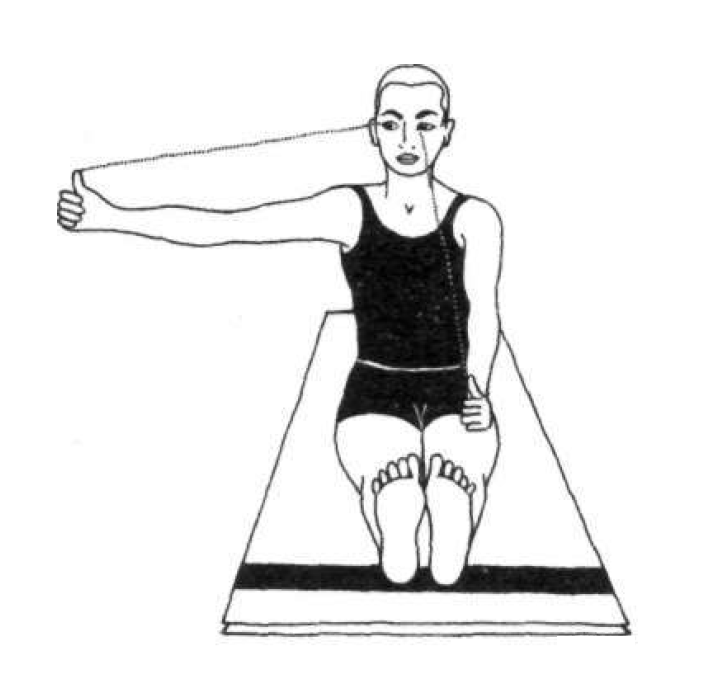
Front and sideways viewing 4
Exercise 4: Front and sideways viewing
Maintain the same body position as in exercise 3 but place the left thumb on the left knee so that it points upward.
Hold the right thumb to the right of the body so that it points upward.
Without moving the head, focus the eyes on the left thumb, then on the right thumb and then return to the left thumb.
Repeat this process 15 to 20 times, then rest and close the eyes.
Repeat the same procedure on the left side of the body.
Keep the head and spine straight throughout.
Finally, close and rest the eyes.
Palming may be performed several times.
Breathing:
Inhale in the neutral position.
Exhale while looking down.
Inhale while looking up.
Benefits: Front and sideways viewing improves coordination of medial and lateral muscles.
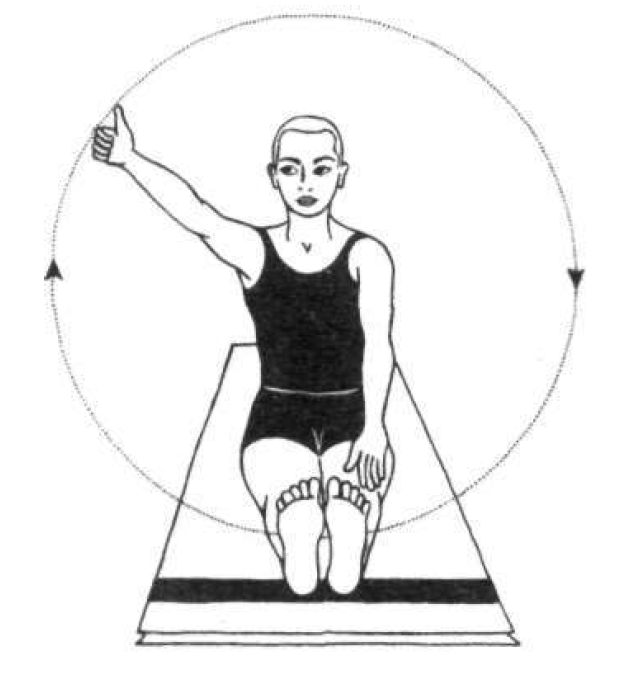
Rotational viewing 5
Exercise 5: Rotational viewing
Maintain the same body position as in exercise 4.
Place the left hand on the left knee.
Hold the right fist above the right leg with the right thumb pointing upward and the elbow straight.
Make a large circular movement with the right arm to the left, then upward, curving to the right, and finally returning to the starting position.
Keep the eyes focused on the thumb without moving the head.
Perform 5 times clockwise and then 5 times anti-clockwise.
Repeat with the left thumb.
Keep the head and spine straight throughout.
Finally, close and rest the eyes.
Palming may be performed several times.
Breathing:
Inhale while completing the upper arc of the circle.
Exhale while completing the lower arc.
The breath should be smooth and synchronised with the forming of a perfect circle.
Benefits:
Rotational viewing restores balance in the muscles surrounding the eyes and improves coordinated activities of both eyeballs.
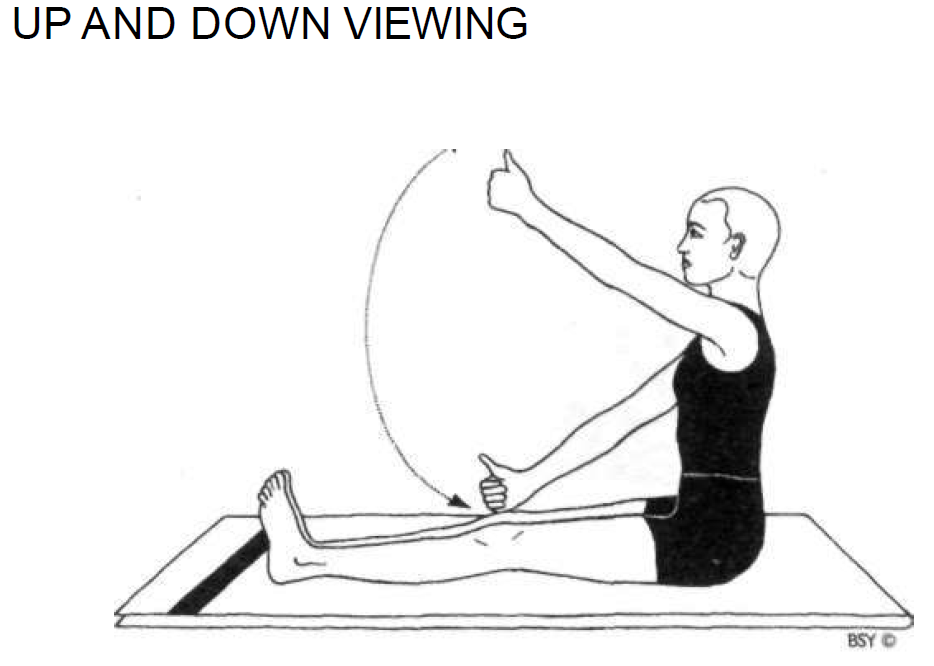
Up and down viewing 6
Exercise 6: Up and down viewing
Maintain the same position as in exercise 5.
Place both fists on the knees with both thumbs pointing upward.
Keeping the arms straight, slowly raise the right thumb while following the motion of the thumb with the eyes.
When the thumb is raised to the maximum, slowly return to the starting position, all the time keeping the eyes focused on the thumb without moving the head.
Practise the same movement with the left thumb.
Repeat 5 times with each thumb.
Keep the head and spine straight throughout.
Finally, close and rest the eyes.
Palming may be performed several times.
Breathing:
Inhale while raising the eyes.
Exhale while lowering the eyes.
Benefits: Up and down viewing balances the upper and lower eyeball muscles.
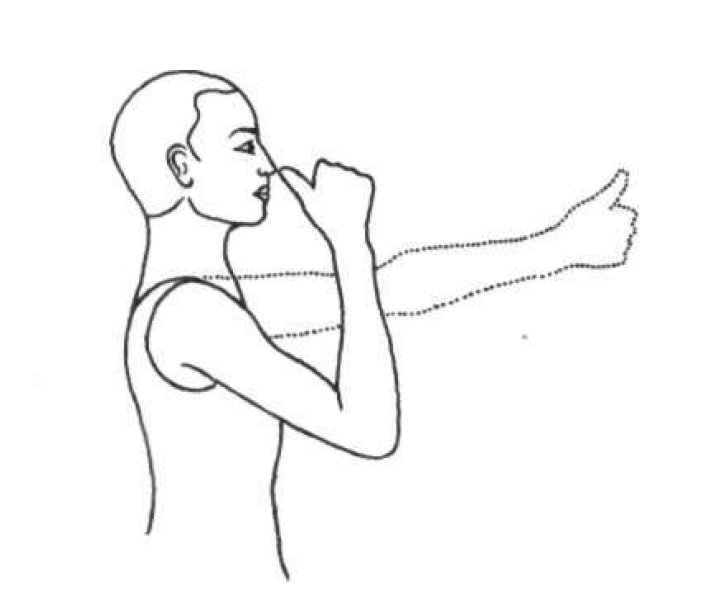
Nosetip Gazing Preliminary Nasikagra Drishti 7
Exercise 7:
Preliminary Nasikagra Drishti (preliminary nosetip gazing)
Sit with the legs straight in front or in a cross-legged pose.
Hold the right arm straight directly in front of the nose.
Make a fist with the right hand, keeping the thumb pointing upward.
Focus both eyes on the tip of the thumb.
Bend the arm and slowly bring the thumb to the nose tip, keeping the eyes focused on the tip of the thumb.
Remain for a few seconds with the thumb held at the nose tip and the eyes focused there.
Slowly straighten the arm, continuing to gaze at the thumb tip.
This is one round.
Practise 5 rounds.
Breathing:
Breathe in as the thumb is drawn towards the nose.
Retain inside while holding the thumb at the nose tip.
Breathe out as the arm is straightened.
Benefits:
This exercise improves the accommodating and focusing power of the eye muscles.
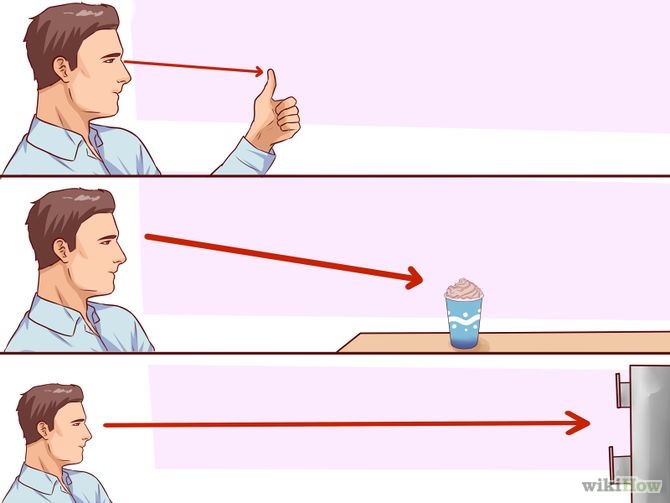
Near and Distant Viewing 8
Exercise 8: Near and distant viewing
Stand or sit at an open window, preferably with a clear view of the horizon, with the arms by the sides.
Focus the eyes on the nose tip, nasikagra drishti, for 5 seconds.
Then, focus on a distant object on the horizon for 5 seconds.
Repeat this process 10 to 20 times.
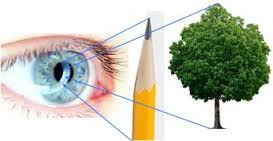
Close the eyes and relax.
Palming may be performed at this time.
Breathing: Inhale during near viewing.
Inhale during near viewing.
Exhale during distant viewing.
Benefits:
Same as for Exercise 7 but the range of movements is further increased.
Practice note: Lie in
Lie in shavasana for a few minutes after completing all 8 exercises.
Yoga Exercises for the Eyes:-
Glasses improve vision but do not cure bad eyesight. Factors which contribute to bad eyesight are: artificial and bad lighting, prolonged television or video watching, poor diet, muscle inefficiency due to prolonged hours of office work and study, mental and emotional tension, toxic condition of the body and ageing. Long periods of reading do not damage the eyes providing the mind and eyes are relaxed whilst doing so. If there is tension, then even a short period of reading can strain the eyes. Try to develop the ability to read with relaxed awareness and blink frequently and also do palming to cool the eyes.
One exercise for relaxing the eye muscles is to stand with the feet shoulder width apart in front of a wide open space. Shift the weight of the body onto one side, raise the opposite heel off the ground, then swing back and forth for a few minutes while gazing into the distance, allowing the eyes to relax.
Gazing at the rising sun during the first 15 degrees of its trajectory from the horizon is highly recommended. After gazing for a few minutes, close the eyes and become aware of the after image. Look over each shoulder from side to side, keeping the eyes closed. At the same time, follow the after image as it moves back and forth through the field of inner vision, from centre to periphery and back again. Practise palming.
Therapeutic yoga exercises:
Excluding diseases such as glaucoma, trachoma and cataract, the most common eye disorders today are related to functional defects in the ocular muscles exacerbated by chronic mental and emotional tension.
The following simple exercises help to alleviate various disorders related to the malfunctioning of the eye muscles such as short and long-sightedness, myopia and squint.
Preparation: Before starting the practices, it is a good to splash cold water onto the eyes a few times. Hold a little water in the palms above a water basin and splash it onto the eyelids. Do this about 10 times and then begin the exercises. This procedure will help stimulate the blood supply and generally tone up the eyes.
Contra-indications: Those who suffer from major eye diseases or disorders such as glaucoma, trachoma, cataract, retinal detachment, retinal artery or vein thrombosis, iritis, keratitis or conjunctivitis should only perform yoga practices after consulting an eye specialist. Inverted asanas and kunjal kriya should be avoided altogether while the condition lasts.
Practice notes: Eye exercises should be performed one after the other in the sequence given. The series should be practiced in its entirety, once early in the morning and/or once in the evening. The most important thing to remember during practice is to be totally relaxed. Do not strain as this will lead to fatigue and tiredness of the eyes. The facial muscles, eyebrows and eyelids should remain totally relaxed. After each exercise the eyes should be closed and rested for at least half a minute. The practice of palming may be performed at this time. Glasses should not be worn while performing the exercises.












